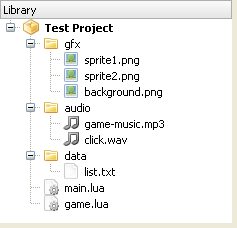File system
The Ultimate Guide to Gideros Studio
File system
In Gideros runtime, there are 3 kinds of directories:
- resource directory
- document directory
- temporary directory
Resource directory
Your code, images, audios and all other files reside in the resource directory. Consider the test project below, and examine the 3 directories and corresponding files.
The files seen above are stored on a real device and Gideros Player like the following:
{resource directory}/gfx/sprite1.png
{resource directory}/gfx/sprite2.png
{resource directory}/gfx/background.png
{resource directory}/audio/game-music.mp3
{resource directory}/audio/click.wav
{resource directory}/data/list.txt
{resource directory}/main.lua
{resource directory}/game.lua
The resource directory is the default directory. Therefore, to access the files you specify the file path as it is:
local sprite1 = Texture.new("gfx/sprite1.png")
local sprite2 = Texture.new("gfx/sprite2.png")
local background = Texture.new("gfx/background.png")
local music = Sound.new("audio/game-music.mp3")
local click = Sound.new("audio/click.wav")
You can also use the io library provided by Lua:
io.read("data/list.txt")
Document directory
You can store a file created by your application in the document directory. The files created in this directory are permanent among application sessions. For example, you can create and then read files in the document directory to save player progress, or keep latest GPS coordinates, ...
In order to specify a file in the document directory, append |D| at the beginning of the filename:
io.write("|D|save.txt")
Temporary directory
Gideros Studio provides a temporary directory to store files that may not stay permanent between different sessions. Therefore, files created in this directory are not guaranteed to exist when the application runs next time, and may be deleted after the application session finishes.
In order to specify a file in the temporary directory, append |T| at the beginning of the file name. Example:
io.write("|T|tempfile.txt")
Note: you can access the files in the resource directory by adding "|R|" at the beginning of the file name, but you don't need to:
local sprite1 = Texture.new("|R|gfx/sprite1.png")
To sum up, here's a list of file operations on the device:
-- open file.txt in the resource directory to read
io.read("file.txt")
-- open file.txt in the resource directory to read (same as above)
io.read("|R|file.txt")
-- open file.txt in the document directory to read
io.read("|D|file.txt")
-- open file.txt in the temporary directory to read
io.read("|T|file.txt")
File execution order
By default Gideros executes all your project Lua files.
- init.lua will always be executed first
- then all the files in alphabetical order (upper case first, then lowercase), while resolving code dependencies provided
- main.lua will always be executed last
Note: the rule about main.lua and init.lua only applies to top level files. If they are in sub directories, they lose their specificity.
strict.lua
strict.lua checks uses of undeclared global variables.
If strict.lua is executed, all global variables must be ‘declared’ through a regular assignment (even assigning nil will do) in a main chunk before being used anywhere or assigned to inside a function.
Although optional, it is a good habit to use it when developing Lua code.
For a detailed explanation of strict.lua, please refer to http://www.lua.org/pil/14.2.html
To execute strict.lua before all other Lua files, simply add strict.lua and init.lua to asset library and make strict.lua dependent to init.lua.
You can download strict.lua from File:Strict.lua that originally comes with the Lua distribution.
PREV.: Event system
NEXT: Profiling
